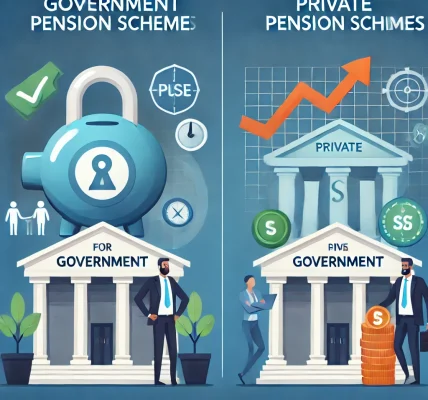Introduction
Planning for retirement is one of the most crucial financial decisions one can make. With several options available, choosing between a pension scheme and a retirement savings plan can be challenging. Both options offer financial security in the later years of life, but they work differently in terms of contributions, benefits, tax implications, and withdrawal policies. This blog will compare pension schemes and retirement savings plans, helping you determine which one is better suited for your retirement goals.
Understanding Pension Schemes
A pension scheme is a retirement plan where an individual contributes regularly during their working years, and upon retirement, they receive a steady income or lump sum amount. Pension schemes can be categorized into government-backed schemes and private pension plans.
Types of Pension Schemes
- Government Pension Schemes
- Employees’ Pension Scheme (EPS): Available for employees covered under the EPF Act, EPS provides monthly pension benefits.
- National Pension System (NPS): A voluntary pension scheme regulated by PFRDA that offers tax benefits and a mix of equity and debt investments.
- Atal Pension Yojana (APY): A government-backed scheme for workers in the unorganized sector, offering fixed pension amounts.
- Private Pension Plans
- Annuity Plans: Offered by insurance companies, annuity plans provide a guaranteed income for life after retirement.
- Defined Contribution Plans: These plans involve investing funds in mutual funds, bonds, or other financial instruments.
Advantages of Pension Schemes
- Guaranteed income after retirement.
- Government pension schemes provide tax benefits.
- Lower risk as compared to market-based savings plans.
Disadvantages of Pension Schemes
- Lack of flexibility in fund withdrawals.
- Some pension schemes have lower returns compared to market-linked investments.
Understanding Retirement Savings Plans
A retirement savings plan is an investment-based savings strategy that allows individuals to accumulate wealth for their post-retirement years. These plans are generally self-managed and offer flexibility in choosing the investment options.
Types of Retirement Savings Plans
- Provident Funds
- Employee Provident Fund (EPF): A savings scheme where both employer and employee contribute a fixed percentage of salary.
- Public Provident Fund (PPF): A long-term savings option with tax benefits and a fixed interest rate.
- Investment-Based Retirement Plans
- Mutual Funds (Retirement Funds): Market-linked funds that offer better returns over the long term.
- Fixed Deposits and Bonds: Fixed-income instruments that provide stable returns.
- Unit Linked Insurance Plans (ULIPs): A combination of insurance and investment offering long-term benefits.
Advantages of Retirement Savings Plans
- Higher flexibility in choosing investment options.
- Potentially higher returns compared to traditional pension schemes.
- Partial withdrawal options available in some plans.
Disadvantages of Retirement Savings Plans
- Market-linked investments carry risks.
- No guaranteed pension or regular income post-retirement.
Pension Schemes vs. Retirement Savings Plans: A Comparison
| Feature | Pension Schemes | Retirement Savings Plans |
|---|---|---|
| Nature of Plan | Pre-defined pension structure | Self-managed investment |
| Returns | Fixed or guaranteed | Market-linked and variable |
| Risk Level | Low | Moderate to high |
| Liquidity | Limited access | Higher flexibility |
| Tax Benefits | Available on contributions and payouts | Varies based on investment type |
| Post-Retirement Income | Regular pension income | Lump sum or self-managed withdrawals |
Which One is Better for You?
Choosing between a pension scheme and a retirement savings plan depends on various factors such as risk appetite, income level, and retirement goals.
- If you prefer stability and guaranteed income → A pension scheme is a better option.
- If you are comfortable with market risks and want higher returns → A retirement savings plan is more suitable.
- For a balanced approach → A combination of both pension schemes and retirement savings plans can provide financial security and growth potential.
Conclusion
Both pension schemes and retirement savings plans have their unique benefits and drawbacks. The best approach is to assess your financial goals, risk tolerance, and retirement needs before making a decision. Combining both options can be the most effective strategy to ensure a comfortable and financially secure retirement.




